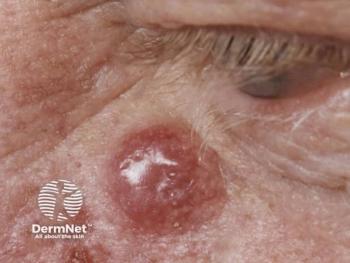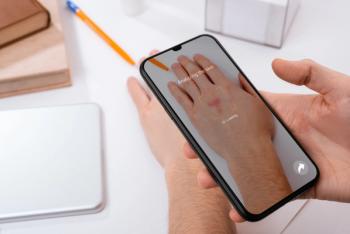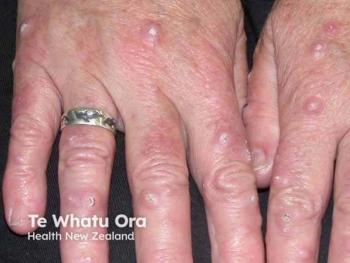
Disruptive technologies expand NMSC tx options
Minimally invasive radiation therapy techniques may be viable alternatives for treatment of non-melanoma skin cancers in a variety of situations.
Mohs micrographic surgery (Mohs) remains the gold standard for achieving cures when treating non-melanoma skin cancers, but there is a definite role for minimally invasive radiation therapy techniques using high-dose-rate electronic brachytherapy (HDR EBX) or superficial radiation, according to Hayes B. Gladstone, M.D.
Unlike the radiation treatments that have long been used by dermatologists, the minimally invasive methods deliver higher doses per fraction and so involve fewer sessions. Based on their beam delivery features, the minimally invasive methods have less potential to cause collateral tissue damage.
“Although there is a need for more high level evidence on both minimally invasive radiation techniques, available data support their consideration as viable non-surgical treatment options for NMSC in situations where surgery can be challenging or for addressing the realities of patient centered care,” says Dr. Gladstone, a fellowship-trained Mohs surgeon now in private practice in San Ramon, Calif.
The case for minimally invasive radiation
While safety and efficacy are the foremost considerations when choosing treatment for skin cancer, patients today also want less invasive procedures, notes Dr. Gladstone.
“Although they tend to be older, people who are in the age group most likely to develop NMSCs often do not want or cannot afford to have downtime after surgery because they may still be working and leading active lives,” he says.
Other situations where minimally invasive radiation can fill a niche are for patients averse to surgery for other reasons, such as those with “Mohs fatigue” and for frail individuals who are not good surgical candidates. In addition, it can be a desirable alternative to surgery for anyone on blood thinners or with larger tumors at sites that are cosmetically sensitive or prone to poor healing.
“Despite having to come back for 8 or 10 visits, patients like that, in contrast to surgery, the radiation therapy involves no needles, pain, blood, bandages, or wound care,” explains Dr. Gladstone. “In addition, they find the cosmetic outcome more acceptable. Although hypopigmentation can develop at the treated site, patients seem to consider this more of a blemish than a scar.”
NEXT: Overview and outcomes
Overview and outcomes
HDR EBX involves placement of a miniature low-energy x-ray tube source rather than a radioisotope. Therefore, it can be performed in the office, in a treatment room without the traditional lead vault. Although dermatologists are becoming trained to provide HDR EBX, it is traditionally performed by a radiation oncologist and requires a physicist to be present.
Each HDR EBX treatment takes about 15 minutes, and they are generally performed twice a week for a total of eight to twelve visits.
Superficial radiation uses a very focused beam to deliver low-energy photons that penetrate no more than 1 cm below the surface of the skin, so that deep and collateral tissue damage is minimized. Lead wall protection is needed in rooms used for superficial radiation, but the treatment does not need to be provided by a radiologist. Each treatment takes only 90 seconds; however, depending on the tumor characteristics, including site and size, between five and 22 fractions are needed.
Although HDR brachytherapy using radioisotopes has been performed since the 1980s and has been used to treat thousands of skin cancers, there is much less data on the HDR EBX that was recently introduced. Considering that the doses over the therapeutic range are comparable for HDR and radioisotope-based skin brachytherapy, it seems reasonable that the efficacy outcomes should be similar for the two techniques, Dr. Gladstone says, adding, however, that “HDR EBX has the advantage reducing dose delivery to non-target structures.”
The evidence
Reported series of HDR EBX for treatment of NMSC include one retrospective study that found no recurrences among 275 tumors during follow-up ranging from one to 38 months.1 Another study including 524 NMSCs followed for an average of 12.5 months reported four recurrences.2 There were also no recurrences reported in the only prospective study to date, but it included only 23 lesions with follow-up to six months.3 Other investigators using more fractions showed a 97.5% cure rate.4
The safety profile of HDR EBX has been good, as it has generally been associated with only mild acute effects and mild hypopigmentation as a late adverse effect. However, the investigators using a higher number of fractions found significant adverse effects when treating lesions on the lower limbs, notes Dr. Gladstone.
There are also few reports on outcomes of superficial radiation even though this technique has been used for several decades to treat NMSCs. The largest series comprised 1715 tumors with follow-up ranging from one to 120 months (mean 31.5 months).5 The reported recurrence rate was 1.9% at two years and 5% at five years, with the five-year rate being a little higher for squamous cell carcinomas vs. basal cell carcinomas (BCCs). Tumors in men and with a diameter >2 cm were more likely to recur.
In another study, investigators in Spain reported a 94.4% cure rate when treating 604 basal cell carcinomas between 1971 and 1997.6
NEXT: Cost considerations
Cost considerations
With today’s focus on value-based medicine, high cost has been another argument against performing HDR EBX. Beginning in 2016, there was a dramatic change in reimbursement that is making the procedure more ethically and economically viable, says Dr. Gladstone.
“Reimbursement for HDR EBX depends on the number of fractions delivered, but until 2016 it could be as high as $20,000 or more per lesion, which is an outrageous cost to society for a condition that has a very low mortality rate with other less expensive and effective treatments,” he says.
With the introduction of a new Medicare temporary code for EBX treatment of skin cancer on January, 1, 2016, the reimbursement rate has fallen to around $500 per fraction, although there is regional variation.
“Given that HDR EBX usually entails eight to 12 fractions, the reimbursement is still higher than the average Mohs procedure. But now at least it is a more viable option in selected patients,” Dr. Gladstone says.
Controversy continues
Although some opine that there is not enough data to justify use of minimally invasive radiation techniques for treating NMSCs, the same argument can be made for other procedures used by dermatologists, Dr. Gladstone says.
Moreover, the only way to gather data is through experience and controlled studies, and Dr. Gladstone believes dermatologists are best-suited to lead the way.
“Dermatologists are the undisputed experts in skin cancer diagnosis and treatment, and optimal delivery of patient care entails the ability to provide as many different treatment options as possible so that we can match the approach to the needs of the individual,” he explains.
“It is important that our specialty adopt, adapt, and become adept at new disruptive technologies that are less invasive and effective. And, we should integrate them as appropriate into our treatment protocols so that we can develop guidelines and be positioned to remain the expert providers.”
Disclosure: Dr. Gladstone is on the medical advisory board of Elekta, a company that markets a device for HDR EBX.
References
1. Bhatnagar A. Electronic brachytherapy for the treatment of nonmelanoma skin cancer: Results at 3 years. Int J Rad Oncol. 2013;87(2):S65.
2. Doggett S, Willoughby M, Willoughby C, Mafong E, Han A. Incorporation of electronic brachytherapy for skin cancer into a community dermatology practice. J Clin Aesthet Dermatol. 2015;8(11):28-32
3. Ballester-Sánchez R, Pons-Llanas O, Candela-Juan C, Celada-Alvarez FJ, de Unamuno-Bustos B, Llavador-Ros M, et al. Efficacy and safety of electronic brachytherapy for superficial and nodular basal cell carcinoma. J Contemp Brachytherapy. 2015;7(3):231-238.
4. Sinha R, Kurtzman S, McIlmoil N, Morganroth G. One-year experience of electronic brachytherapy for the treatment of nonmelanoma skin cancer. Oncology. 2014;28(4 Suppl 1):P127.
5. Cognetta AB, Howard BM, Heaton HP, Stoddard ER, Hong HG, Green WH. Superficial x-ray in the treatment of basal and squamous cell carcinomas: a viable option in select patients. J Am Acad Dermatol. 2012;67(6):1235-1241.
6. Hernández-Machin B, Borrego L, Gil-García M, Hernández BH. Office-based radiation therapy for cutaneous carcinoma: evaluation of 710 treatments. Int J Dermatol. 2007;46(5):453-459.
Newsletter
Like what you’re reading? Subscribe to Dermatology Times for weekly updates on therapies, innovations, and real-world practice tips.


















